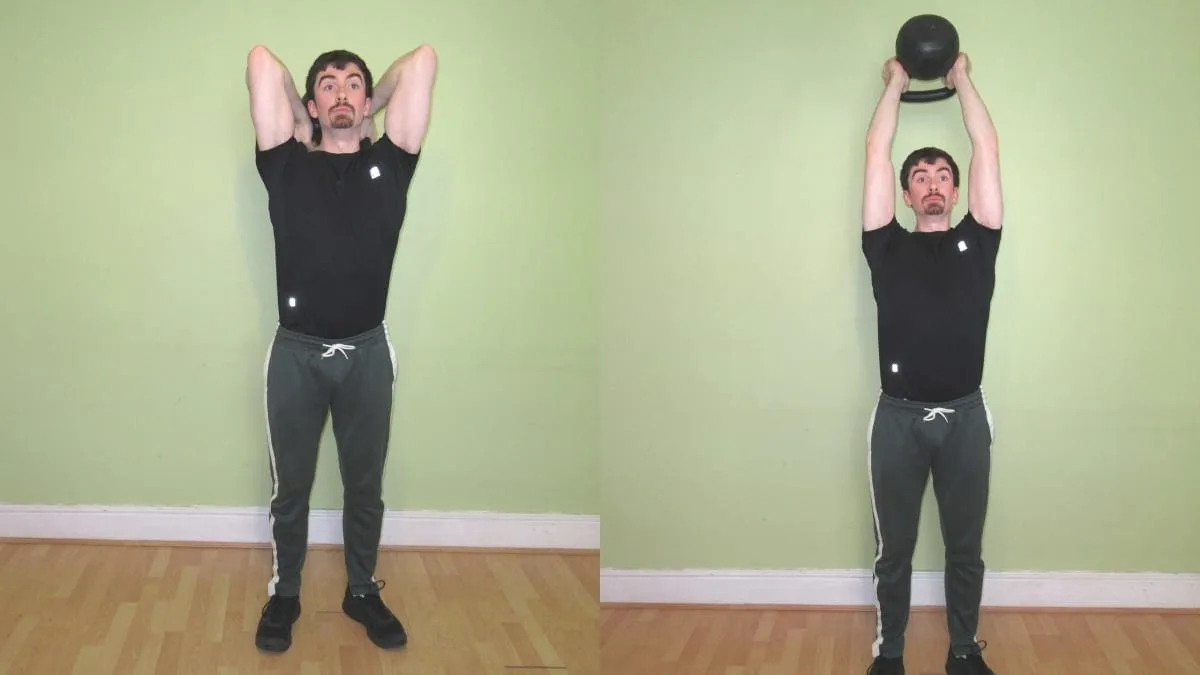Understanding how the triceps brachii acts is essential for maximizing your arm training endeavors. You need to know how to train both tricep functions (elbow extension and shoulders extension) if you want to get the best results.
Thankfully, understanding the biomechanical basics isn’t difficult.
The kettlebell French press and the barbell French press are two exercises that work both functions of the triceps simultaneously.
This is because exercises that put your arms into an overhead position automatically place your shoulders into flexion, which in turn puts the long head of the triceps (the biggest head and the only one that acts on the shoulder) under a greater stretch. As such, any kind of French press has, by definition, excellent size-building potential.
The following guide demonstrates 9 total kettlebell French press variations that you can perform to add muscle to your triceps.
Related: Kettlebell tricep exercises
Kettlebell French press exercise details
- Also Known As: KB French press
- Main Muscles: Triceps
- Exercise Type: Strength
- Exercise Mechanics: Isolation
- Difficulty Level: Intermediate
- Equipment Needed: Kettlebells
How to do a French press with kettlebells
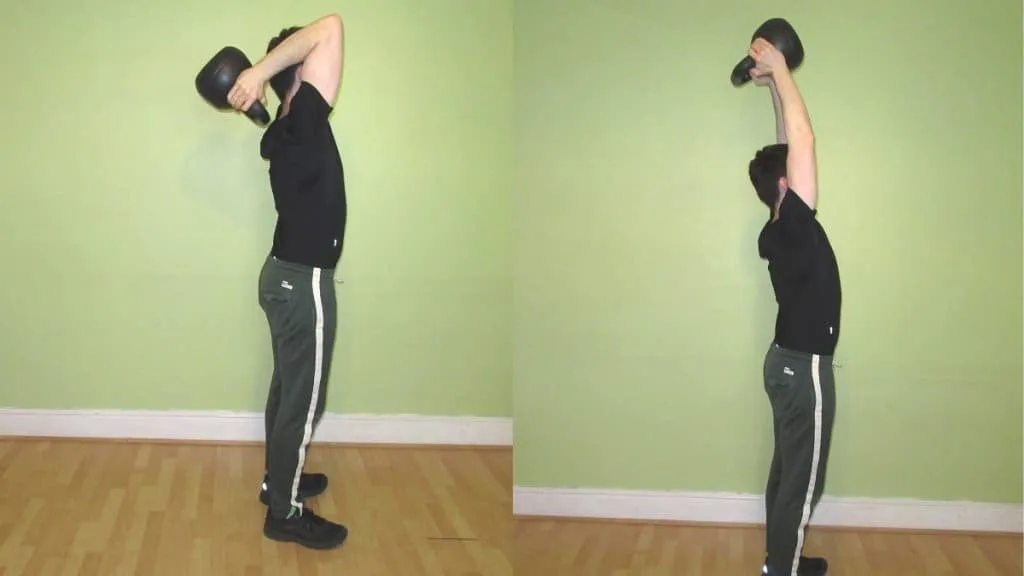
- Grab a kettlebell with an overhand grip.
- Stand up straight and tighten your core.
- Press the kettlebell over your head so that your arms are fully extended.
- Lower the weight behind your head by bending your elbows.
- Descend until you feel an intense stretch in your triceps (most likely when your biceps and forearms press up against each other).
- Reverse the motion by extending your elbows and keep going until your elbows are fully extended.
- Flex your triceps at the top of the rep.
- Repeat for 3-5 sets of 10-20 reps.
Kettlebell French press variations
These 8 KB French press variations will keep your mind occupied and your triceps growing for many months.
Seated kettlebell French press
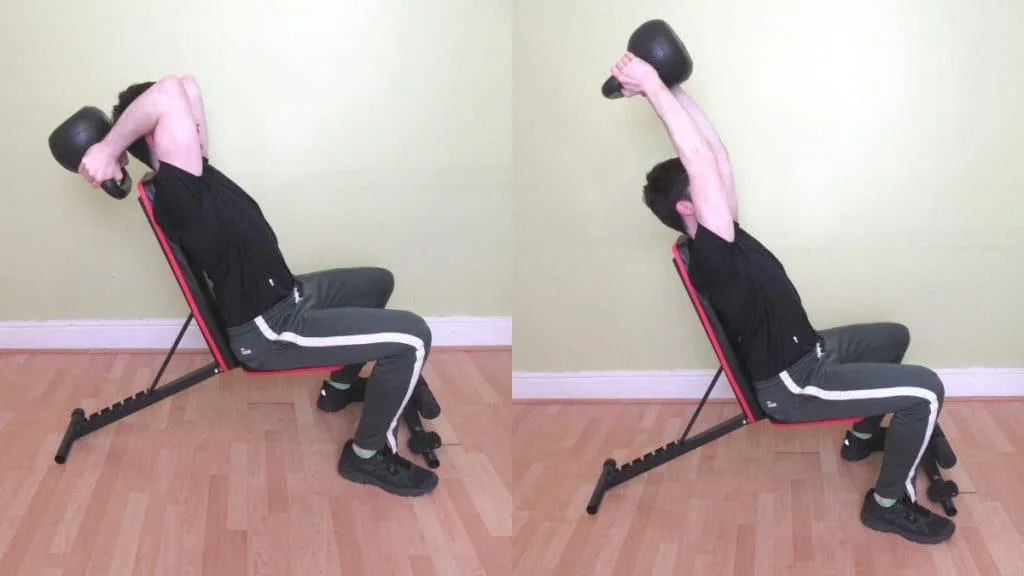
The seated kettlebell French press is an ideal isolation exercise because it takes your core pretty much out of the movement completely and lets you focus on training your triceps as a result.
This is because the backrest of the bench does most of the stabilization work that your abs would usually perform during the standing kettlebell French press.
So while the seated version doesn’t burn as many calories as the standing variation due to the fact that your legs and ab muscles aren’t as active, the sitting French press does provide better triceps isolation out of the box.
Of course, if you already have a strong core and a solid mind-muscle connection from years of strength training, then it probably doesn’t matter whether you do the KB French press in a standing or seated position.
And besides, if you’re performing moderate or high rep sets, then it’s doubtful that you’ll be lifting enough weight to where your core stability becomes an issue.
Incline kettlebell French press

The kettlebell incline French press exercise is a great mass-building movement for the triceps because it puts the long head, which is the largest muscle of the triceps, in a strong, force-producing, and highly stretched position.
So not only can you lift plenty of weight during the incline kettlebell French press, but your triceps also get put under an optimal, growth-stimulating muscle stretch. The exercise is, in other words, a recipe for triceps hypertrophy.
The only drawback is that the incline kettlebell French press isn’t ideal for training to failure. This is because if you reach failure when your triceps are stretched (which is likely considering that that’s the hardest part of the rep), then you could get stuck with the kettlebell behind the bench, which would put your shoulders and elbows in a compromising position.
Therefore, it’s a good idea to recruit a spotter before your set if you plan on training to failure. You don’t want to get yourself into a position where you’re forced to drop the kettlebell to get yourself out of trouble because that could be very dangerous for the people working out around you.
Decline kettlebell French press

Performing the French press on a decline bench places your triceps under a strong stretch because, due to the sloping angle of the bench, the kettlebell is always trying to pull your arms backward.
This backward force means that your triceps—even when your elbows are locked out—have to work extra hard to lift and stabilize the weight, which results in a more effective muscle-building workout.
Yet, because the bench is at a decline angle, the movement also demands more core strength than other kinds of kettlebell French presses. That is, of course, unless your decline bench has a footpad, in which case you’ll be able to focus purely on training your triceps.
Lying kettlebell French press
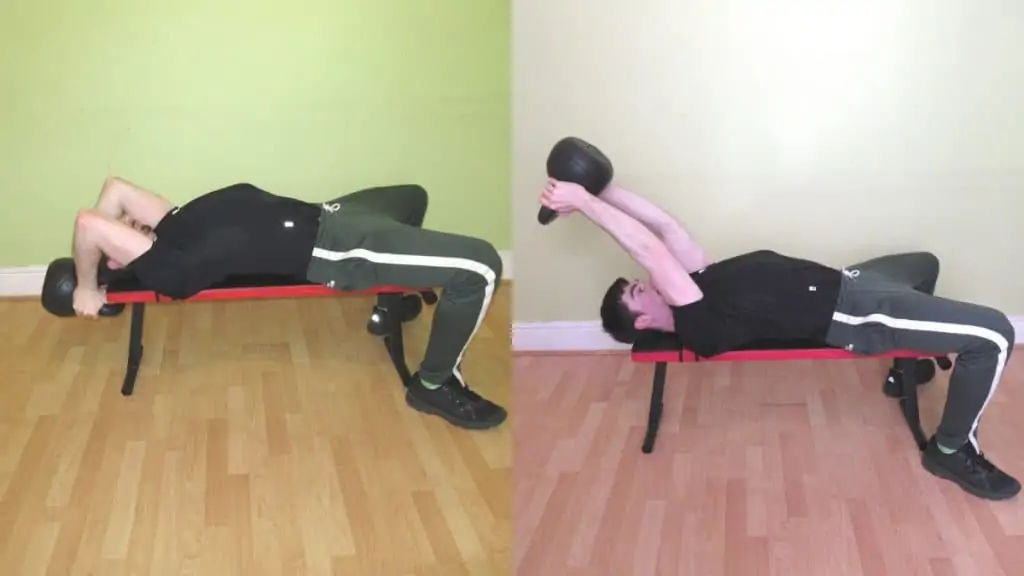
The lying kettlebell French press is a great exercise to do if you struggle to get your shoulders all the way over your head during the standing version. This is because your shoulders are in a lower degree of flexion when you’re laid down compared to when you’re standing up.
Additionally, because you’re lying on a bench, the lying kettlebell French press also requires less core strength than the standing kettlebell French press.
This means that you can put more effort into training your triceps because you don’t have to put anywhere near as much energy into contracting your abs; the bench basically does the stabilization work for you.
Floor kettlebell French press
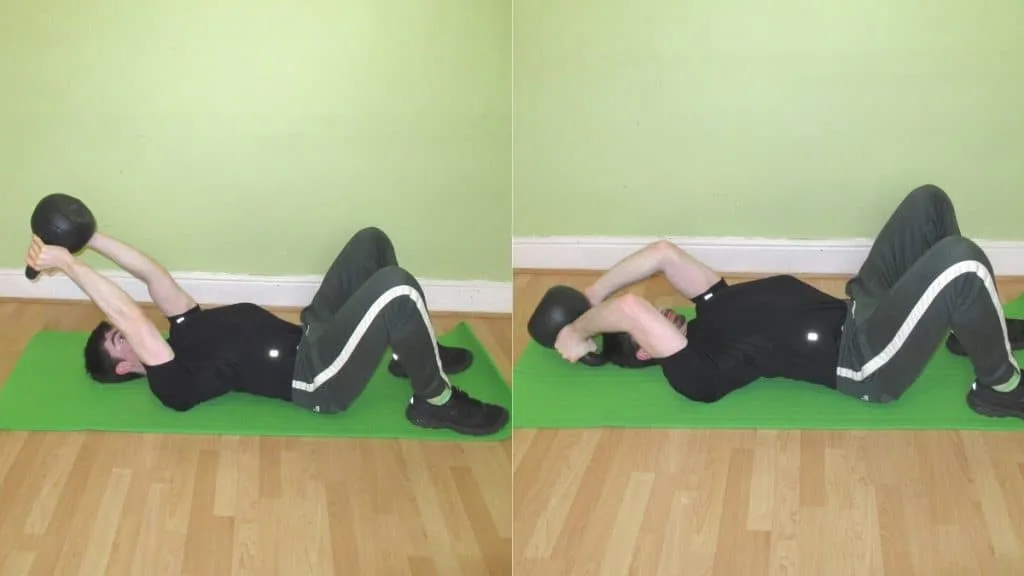
If you don’t have a weight bench but still want to challenge your triceps, then give the kettlebell floor French press a try.
While you don’t quite get as much range of motion as you do during the bench versions of the exercise, performing a floor French press with kettlebells makes it easy to create a standardized lifting technique.
By touching the weights to the floor on every rep, you know that you’re using a consistent range of motion. Therefore, when you gain strength, you know that it’s truly a result of your triceps getting stronger, not because you’re reducing the range of motion in order to lift heavier weights.
Additionally, although you don’t technically need a workout mat for this movement, lying on a mat will certainly make the exercise more comfortable, especially if you’re challenging your triceps with a heavy kettlebell.
One arm kettlebell French press

The kettlebell one arm French press is typically performed in a standing position (though you can do it seated as well) and is an effective exercise for improving your upper body aesthetics by making your triceps more proportional.
So if your triceps have plenty of size but lack the symmetry to look truly aesthetic, then it could be well worth your time (your sets will take longer when you train unilaterally) to do the single arm kettlebell French press.
If you don’t fancy spending extra time in the gym to work your triceps separately, however, then you could always do a kettlebell French press with a separate weight in each hand where you lift both weights at the same time.
While lifting two independent weights at the same time doesn’t quite allow for the quality of mind-muscle connection that training unilaterally does, it’s definitely a lot quicker than training each tricep separately and still helps to make sure that both of your arms are getting equal amounts of work.
Kneeling kettlebell French press
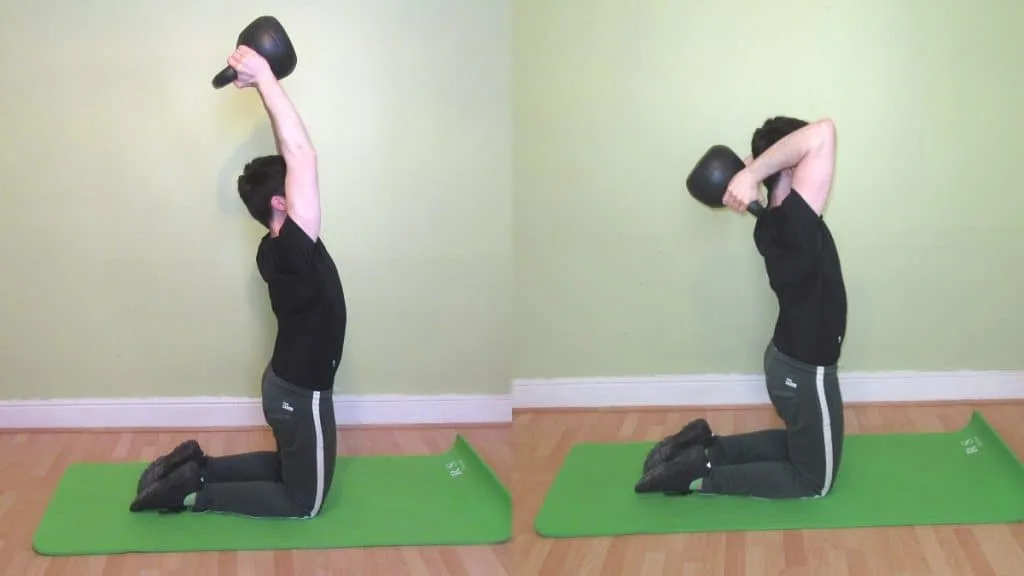
Do the kettlebell tall kneeling French press if you want to improve your isometric ab strength while challenging your triceps.
You might not be overly concerned with strengthening your core isometrically if you’re a hypertrophy-focused bodybuilder. However, such strength is readily transferable to your compound movements like squats and overhead presses because it gives you a more stable base to lift from.
On the other hand, you could argue that since the KB French press is an isolation exercise, you should do everything in your power to make it a more triceps-dominant movement.
So, depending on your point of view, the kneeling kettlebell French press is either the best or worst exercise in this guide because it’s the one that requires the most core strength.
Kettlebell French press on an exercise ball

Performing a kettlebell French press on a stability ball works your abs well, but not to the same extent that the kneeling version does.
But this small difference in ab activation hardly matters because the stability ball kettlebell French press is also highly versatile.
For example, you can sit on the ball and lower the weight behind your head, which is a great variation for beginners.
Or, to work your abs more, you can perform the movement while lying on the ball.
Similarly, you can lift either one or two kettlebells at a time depending on whether you value mass or symmetry more (lifting one large kettlebell enables you to overload your triceps with heavier resistance levels, lifting two ensures that your triceps are getting equal amounts of work).
Conclusion: Should you do the French press with kettlebells?
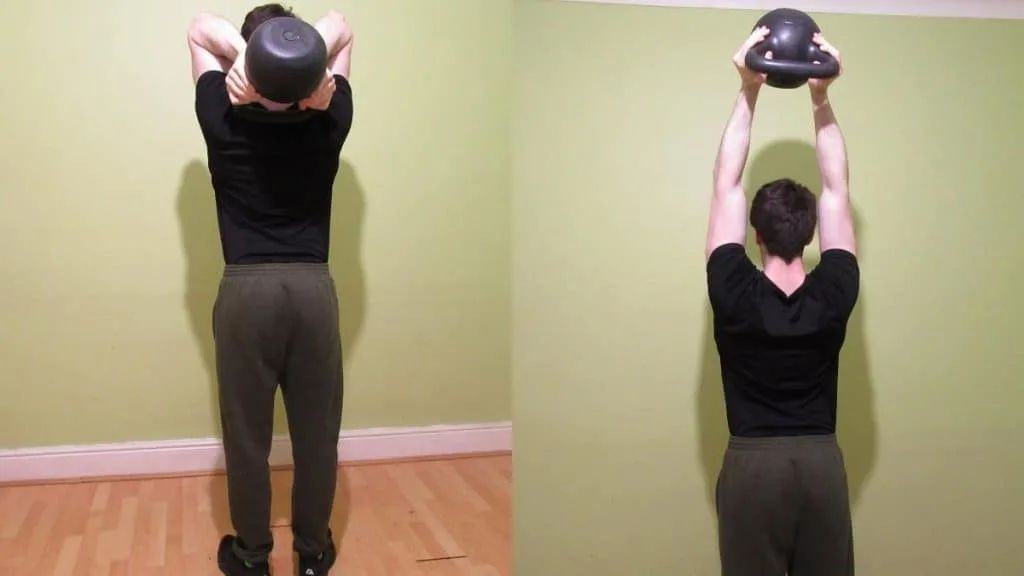
If you want to build triceps mass or make the backs of your arms more toned, then the kettlebell French press will help you to achieve your goals if you perform it consistently.
In addition to working all three tricep heads well, the kettlebell French press works the long head particularly well, which, because the long head is the largest muscle in the triceps, is one reason why you can lift plenty of weight on the KB French press.
Aim for around 10-20 reps on each set. While performing a French press with kettlebells is generally very safe when you use the proper form, any kind of single-joint tricep exercise is naturally going to be quite elbow-intensive, so you don’t want to strain your joints by lifting too heavy.

